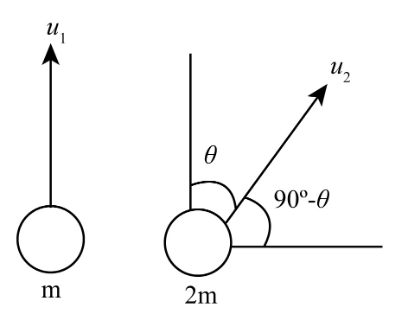
Rishabh and Bappy are playing with two different balls of masses $m$ and $2m$ respectively. If Rishabh throws his balls vertically up and Bappy at an angle $\theta $, both of them stay in our view for the same period. The height attained by the two balls are in the ratio of
(a). $2:1$
(b). $1:1$
(c). $1:\cos \theta $
(d). $1:\sec \theta $
Answer
566.4k+ views
Hint:The two parts of a vector are called components. While analyzing a projectile motion, both the horizontal and vertical components are to be considered independently. When the vertical displacement is considered we can use the vertical component of velocity.
Complete step by step answer:
Let ${u_1}$ be the velocity of the ball thrown by Rishabh in the vertical direction. Let ${u_2}$ be the velocity of the ball thrown by Bappy at an angle of $\theta $ as shown in the figure.

We know that the formula to calculate the time of flight for a projectile motion is $T = \dfrac{{2v}}{g}$, where $v$ is the initial velocity and $g$ is the acceleration due to gravity. Thus the time period for Rishabh is ${T_1} = \dfrac{{2{u_1}}}{g}$.
When the motion is about an angle $\left( \theta \right)$, then the time of flight is calculated as $T = \dfrac{{2v\sin \theta }}{g}$. Thus the time period for Bappy is ${T_2} = \dfrac{{2{u_2}\sin \left( {90 - \theta } \right)}}{g}$. As $\sin \left( {90 - \theta } \right) = \cos \theta $ , we have, ${T_2} = \dfrac{{2{u_2}\cos \theta }}{g}$.
As it is given that the time of flight for both the cases are equal, we have,
${T_1} = {T_2}$
That is,
$
\dfrac{{2{u_1}}}{g} = \dfrac{{2{u_2}\cos \theta }}{g}\\
\Rightarrow{u_1} = {u_2}\cos \theta
$
Now the formula to calculate the maximum height attained by a projectile motion is $H = \dfrac{1}{2}\dfrac{{{v^2}}}{g}$.
Thus the maximum height attained by the ball thrown by Rishabh is, ${H_1} = \dfrac{1}{2}\dfrac{{{u_1}^2}}{g}$.
When the motion is about an angle $\left( \theta \right)$, then the maximum height attained is calculated as,
$
{H_2} = \dfrac{1}{2}\dfrac{{{u_2}^2{{\sin }^2}\left( {90 - \theta } \right)}}{g}\\
\Rightarrow{H_2} = \dfrac{{{u_2}^2{{\cos }^2}\theta }}{{2g}}
$
Thus, the ratio of the height attained is,
$\dfrac{{{H_2}}}{{{H_1}}} = \dfrac{{\left( {\dfrac{{{u_2}^2{{\cos }^2}\theta }}{{2g}}} \right)}}{{\left( {\dfrac{{{u_1}^2}}{{2g}}} \right)}}$
But we have, ${u_1} = {u_2}\cos \theta $. Therefore the ratio becomes,
$
\dfrac{{{H_2}}}{{{H_1}}} = \dfrac{{{u_2}^2{{\cos }^2}\theta }}{{{u_2}^2{{\cos }^2}\theta }}\\
\therefore{H_2}:{H_1} = 1:1
$
Therefore the ratio of the height attained by the two balls is $1:1$.Hence,option (b) is the correct answer.
Note: We should know that the projectile motion is motion that occurs for an object when it is projected into the air and it gets affected by the acceleration due to gravity. The projectile is the object while the path taken by the projectile is known as a trajectory. The formula of projectile motion is used to calculate the velocity, distance, and time observed in the projectile motion of the object.
Complete step by step answer:
Let ${u_1}$ be the velocity of the ball thrown by Rishabh in the vertical direction. Let ${u_2}$ be the velocity of the ball thrown by Bappy at an angle of $\theta $ as shown in the figure.

We know that the formula to calculate the time of flight for a projectile motion is $T = \dfrac{{2v}}{g}$, where $v$ is the initial velocity and $g$ is the acceleration due to gravity. Thus the time period for Rishabh is ${T_1} = \dfrac{{2{u_1}}}{g}$.
When the motion is about an angle $\left( \theta \right)$, then the time of flight is calculated as $T = \dfrac{{2v\sin \theta }}{g}$. Thus the time period for Bappy is ${T_2} = \dfrac{{2{u_2}\sin \left( {90 - \theta } \right)}}{g}$. As $\sin \left( {90 - \theta } \right) = \cos \theta $ , we have, ${T_2} = \dfrac{{2{u_2}\cos \theta }}{g}$.
As it is given that the time of flight for both the cases are equal, we have,
${T_1} = {T_2}$
That is,
$
\dfrac{{2{u_1}}}{g} = \dfrac{{2{u_2}\cos \theta }}{g}\\
\Rightarrow{u_1} = {u_2}\cos \theta
$
Now the formula to calculate the maximum height attained by a projectile motion is $H = \dfrac{1}{2}\dfrac{{{v^2}}}{g}$.
Thus the maximum height attained by the ball thrown by Rishabh is, ${H_1} = \dfrac{1}{2}\dfrac{{{u_1}^2}}{g}$.
When the motion is about an angle $\left( \theta \right)$, then the maximum height attained is calculated as,
$
{H_2} = \dfrac{1}{2}\dfrac{{{u_2}^2{{\sin }^2}\left( {90 - \theta } \right)}}{g}\\
\Rightarrow{H_2} = \dfrac{{{u_2}^2{{\cos }^2}\theta }}{{2g}}
$
Thus, the ratio of the height attained is,
$\dfrac{{{H_2}}}{{{H_1}}} = \dfrac{{\left( {\dfrac{{{u_2}^2{{\cos }^2}\theta }}{{2g}}} \right)}}{{\left( {\dfrac{{{u_1}^2}}{{2g}}} \right)}}$
But we have, ${u_1} = {u_2}\cos \theta $. Therefore the ratio becomes,
$
\dfrac{{{H_2}}}{{{H_1}}} = \dfrac{{{u_2}^2{{\cos }^2}\theta }}{{{u_2}^2{{\cos }^2}\theta }}\\
\therefore{H_2}:{H_1} = 1:1
$
Therefore the ratio of the height attained by the two balls is $1:1$.Hence,option (b) is the correct answer.
Note: We should know that the projectile motion is motion that occurs for an object when it is projected into the air and it gets affected by the acceleration due to gravity. The projectile is the object while the path taken by the projectile is known as a trajectory. The formula of projectile motion is used to calculate the velocity, distance, and time observed in the projectile motion of the object.
Recently Updated Pages
Master Class 12 Business Studies: Engaging Questions & Answers for Success

Master Class 12 Economics: Engaging Questions & Answers for Success

Master Class 12 English: Engaging Questions & Answers for Success

Master Class 12 Maths: Engaging Questions & Answers for Success

Master Class 12 Social Science: Engaging Questions & Answers for Success

Master Class 12 Chemistry: Engaging Questions & Answers for Success

Trending doubts
What is meant by exothermic and endothermic reactions class 11 chemistry CBSE

Which animal has three hearts class 11 biology CBSE

10 examples of friction in our daily life

One Metric ton is equal to kg A 10000 B 1000 C 100 class 11 physics CBSE

1 Quintal is equal to a 110 kg b 10 kg c 100kg d 1000 class 11 physics CBSE

Difference Between Prokaryotic Cells and Eukaryotic Cells




